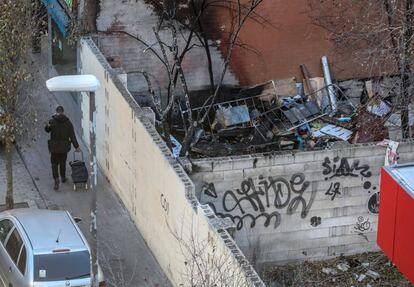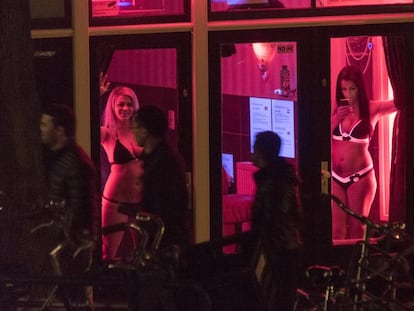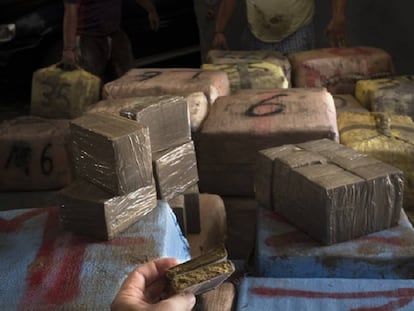Madrid neighborhood fights to stop rising drug dens and violence
Residents of Puente de Vallecas come together to stop addicts and dealers from ruining the community


Drugs have made a comeback in Puente de Vallecas. As local authorities tear down squatter homes in the nearby shantytown of Cañada Real Galiana, drug dealers are being pushed into the inner city, say police sources. A few weeks ago, the neighborhood association La Cacerolada warned that Puente de Vallecas is being “invaded” by drug users as they move into empty apartments in residential buildings. Some neighbors are being threatened. Others are protesting. To date, the local government has shut down just nine of the new drug dens.
They gestured to one neighbor that they would slit her throat
Puente de Vallecas resident Ángela
A local explains: “The other day I saw one injecting himself in the neck. I was in a spot where children pass when they return from school.”
When city and regional authorities began to shut down the illegal homes in the Cañada Real Galiana settlement, the hot spot for drug dealing moved to the city, and with it violence and insecurity. On Monday, a 50-year-old man was knifed to death in a fight with another individual inside the shantytown.
But the neighbors are fighting back. They have been protesting for weeks, bringing thousands of people to the street to demand the government shut down the 50-plus drug dens, increase the police presence on the streets and install surveillance cameras. Most of the homes occupied by drug dealers are foreclosed apartments that now belong to banks or investment funds, and were empty prior to the squatters’ arrival.
Public transportation makes it easy to buy drugs
One of the factors that has led to a rise in drug dealing and consumption in Puente de Vallecas is the ease of public transportation.
Before, anyone wishing to get to Cañada Real had to take a car. There was no public transit network going there, and even taxi drivers refused to drive to Cañada.
But to get to Puente de Vallecas, one need only take Line 1 on the Metro (the closest stations are Nueva Numancia and Puente de Vallecas) or the train to Madrid-Entrevías.
“If the owner does not file a complaint, there is no crime of illegal appropriation, and proving that it is a drug sales point is even more difficult,” says Jorge Nacorino, president of the Puente de Vallecas Neighborhood Association. The city of Madrid announced in November that it would implement a plan to improve security and reduce drug dealing and consumption in the area.
But meanwhile, drug addicts continue to walk the streets and hang about in abandoned lots. On one lot on Convenio Street, the ground is littered with bits of plastic, charred wood, toys, old clothes and other junk. Last week, the lot went up in flames after drug users lit a bonfire. “There are a lot of dry leaves around. At least the temperature has dropped, otherwise imagine what could have happened. There is a gas station right next door,” says a neighbor as she walks amid the debris.
The town cleaning services can’t get access to clean up these spaces because most of them are on private property. “We have told the owners so that they can clean up the rubbish,” explain town hall sources.
Irene, Ángela, Marisa and Lucía (not their real names) are part of a neighborhood group that watches to make sure the drug dens shut down by local authorities are not reopened. They feel threatened and carry pepper sprays and whistles to use in case of an attack. “They gestured to one neighbor that they would slit her throat,” says Ángela. The group also takes down prostitution flyers that pimps slip under car windshield wipers. But despite their efforts, the group says that some of the drug dens closed on November 24 have been occupied again.
Fights between drug dealers and addicts are also frequent, worsening the community’s sense of insecurity and fear: “The other night, through my window, I saw two men threatening each other with knives,” says Ángela.
Locals leave lights on
Many owners are scared that drug dealers will occupy their homes if they are left empty. So when they go on holidays, they ask their neighbors to go into their house and turn on the television and lights. “Some people put on light timers and ask their family to open and close the blinds every now and again,” says Lucía.
If the owner does not file a complaint, there is no crime of illegal appropriation
President of the Puente de Vallecas Neighborhood Association Jorge Nacorino
Lucía rents out an apartment but says rental prices have dropped as a result of the rise in crime: “They leave little marks on the shutters to see if they have been opened and closed, they ring the doorbell to see if anyone answers, and hand out fliers advertising to buy homes, to see which places are empty,” she adds.
The drop in security has also forced many businesses to close. “Now you only find pubs, and at night the streets are filled with prostitutes,” says a group of locals on Monte Igueldo Avenue.
The four women say that while they may be scared, they are not going to give up. They want their community to go back to what it used to be: a place where residents can walk the streets without feeling scared, and where children can grow up safe from harm, and from drugs.
English version by Melissa Kitson.









































